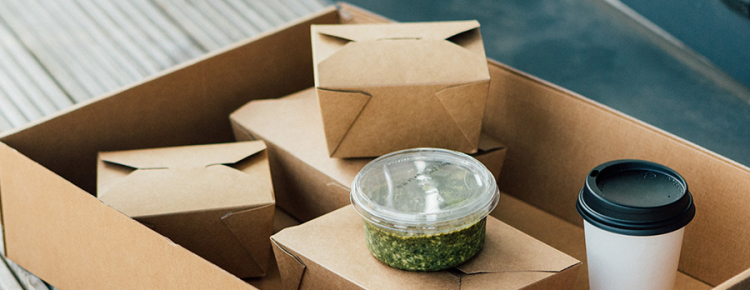
Globally, solid waste entering our landfills inevitably enters the ecosystem. In even the most proactive waste management systems, synthetic materials can negatively impact the environment, biodiversity, and ocean health. Of the potential solid waste, we throw away, packaging, which touches every industry, holds a majority share of residential waste. Items we use once and dispose of trade their short-lived purpose for several lifetimes of damage, making them a tragic result of the convenience culture.
There is good news in Eco-friendly Packaging
As we become more aware, the story of packaging is taking a turn toward eco-friendly options. The global attention to alternative material technologies and the early adopters' companies are not surprisingly peaking consumers' attention and feeding a new industry.
The Global packaging market size is projected to grow from USD 909.2 billion in 2019 to USD 1,012.6 billion by 2021- learn more in our Sustainable Packaging whitepaper.
Packaging and the truth behind the circular economy
The Petroleum products, like plastics packaging, that we use and get rid of result in damaging microplastics to the oceans. Chemical leakage into our environment is sometimes a result of packaging products and mixed materials which are too costly to process for recycling and result in entering landfills or the ocean directly.
Does that seem shocking? Well, it is.
When we process used packaging in recycling plants or transport discarded products, we contribute to environmental toxins like Greenhouse gasses. It’s a dangerous zero-sum game with less undesired outcomes falling to one side or the other. Thinking about it from the perspective of a full life cycle, any product not providing a sustainable packaging solution is a poor choice for the limited resources available. Single-use products are creating a cascade effect of negative environmental impacts.
But we do need containers, bags, protective casings, and merchandising. We can’t simply stop. There are ways to choose materials that provide us with essential packaging, but in some cases, solve problems in our miscalculations of the past.
We’ve taken a few materials from our Sustainable Packaging Whitepaper to share. If this interests you, there is more to learn.
ACCESS THE SUSTAINABLE PACKAGING WHITEPAPER NOW
“First comes thought; then organization of that thought, into ideas and plans; then transformation of those plans into reality. The beginning, as you will observe, is in your imagination.” - Napoleon Hill.
An environmentally conscious business in this age is a company that acknowledges the need to find new solutions and the willingness to invest in taking the first steps. Materials engineers have found ways to grow our way out of the recycling mindset to decomposable. Creative thinkers have found ways to take the products we used to discard and upcycle them. Such products are given a new purpose and a new lifespan.
Some eco-friendly packaging materials you may have missed.

Mushroom packaging
This eco-friendly packaging alternative is made from agricultural waste fused with a matrix of mushroom roots. It is gaining popularity, especially in the food and beverage industry.

Air pillows from recycled material
Traditional bubble wrap made from plastic is not the eco-friendliest of materials. However, the up-cycled version is made from post-consumer waste and is as good at shock-absorbing as the bubble wrap.

Eco-friendly and recycled plastics
Plastics are not about to get eliminated, at least anytime soon. However, there are an array of shipping materials like drums, spill trays, and spill control pallets made from 100% recycled plastic.

Organic Fabrics
Organic fabrics are being used as the first alternative to plastic bags. Made from different materials, including hemp, organic or recycled cotton, tapioca, and palm leaves, even if thrown out, they can biodegrade in around 100 days compared to the 10,000 years it takes for a plastic bag to biodegrade.

Other Bio-based packaging such as Eucalyptus, shrimp shells, coconut18
Eco-friendly packaging is acquiring a chic relationship with luxury companies pushing into the eco-packaging space. Completely dispelling the myth of eco-friendly packaging being uninteresting and bland, a France-based luxury champagne company Veuve Clicquot used potato starch along with natural fibers, paper, and water to create isothermal packaging.
*From Sustainable Packaging in 2021- 5 of the 10 options you can access for free.
One product you will be surprised to learn Isn’t sustainable are most chip bags.
Are you aware of this challenge to chip packaging
Have you ever heard the term wish cycling? It’s the practice of trying to recycle a product that you think should be recyclable, but it isn't. These wish-cycled products clog our processing centers and inevitably end up in the landfill, just not by your hand. The danger of wish cycling is that consumers think they are purchasing products that are not causing harm. Unfortunately, this lack of understanding means that they enable producers to choose the very packaging products that should be removed from the product cycle.
Many Chip Bags are NOT Recyclable

Why? Infused with one type of plastic on the inner shell and another molecularly bonded to the outer shell, these flexible plastic components take too many resources to separate. This makes it a single-use plastic despite what the labeling may tell you.
If you are a Chip Producer, know that there are ways to reduce packaging waste for your products. A lesser-known solution is working to reduce the associated carbon footprint in production.
Looking for another solution?
Open up to Intengine’s Sustainable Packaging Case Studies to learn from the experience of Flexible Packaging Specialist, Glenn Treliving, of Partners Packaging:
“Treliving notes that almost all flexible packaging made today is not recyclable, but with a few exceptions, most could and should be. “
PAGE 6 of ACCESS SUSTAINABLE PACKAGING WHITEPAPER NOW for more tips and support. https://intengine.com/sustainable-packaging-whitepaper
Tags: responsible packaging, eco friendly, reusable packaging, packaging solutions, carbon footprint

